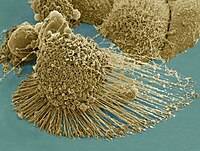
Photo from wikipedia
The chemokine CCL22 recruits regulatory T (T-reg) cells into tumor tissues and is expressed in many human tumors. However, the prognostic role of CCL22 in cervical cancer (CC) has not… Click to show full abstract
The chemokine CCL22 recruits regulatory T (T-reg) cells into tumor tissues and is expressed in many human tumors. However, the prognostic role of CCL22 in cervical cancer (CC) has not been determined. This study retrospectively analyzed the clinical significance of the expression of CCL22 and FOXP3 in 230 cervical cancer patients. Immunohistochemical staining analyses of CCL22 and FOXP3 were performed with a tissue microarray. Double immunofluorescence staining, cell coculture, and ELISA were used to determine CCL22 expressing cells and mechanisms. The higher number of infiltrating CCL22+ cells (CCL22high) group was associated with lymph node metastasis (p = 0.004), Fédération Internationale de Gynécologie et d’Obstétrique (FIGO) stages (p = 0.010), therapeutic strategies (p = 0.007), and survival status (p = 0.002). The number of infiltrating CCL22+ cells was positively correlated with that of infiltrating FOXP3+ cells (r = 0.210, p = 0.001). The CCL22high group had a lower overall survival rate (OS), compared to the CCL22low group (p = 0.001). However, no significant differences in progression free survival (PFS) were noted between the two groups. CCL22high was an independent predictor of shorter OS (HR, 4.985; p = 0.0001). The OS of the combination group CCL22highFOXP3high was significantly lower than that of the combination group CCL22lowFOXP3low regardless of the FIGO stage and disease subtype. CCL22highFOXP3high was an independent indictor of shorter OS (HR, 5.284; p = 0.009). The PFS of group CCL22highFOXP3high was significantly lower than that of group CCL22lowFOXP3low in cervical adenocarcinoma, but CCL22highFOXP3high was not an independent indicator (HR, 3.018; p = 0.068). CCL22 was primarily expressed in M2-like macrophages in CC and induced by cervical cancer cells. The findings of our study indicate that cervical cancer patients with elevated CCL22+ infiltrating cells require more aggressive treatment. Moreover, the results provide a basis for subsequent, comprehensive studies to advance the design of immunotherapy for cervical cancer.
Journal Title: Cancers
Year Published: 2019
Link to full text (if available)
Share on Social Media: Sign Up to like & get
recommendations!